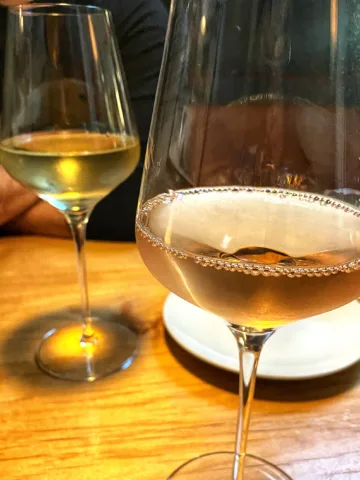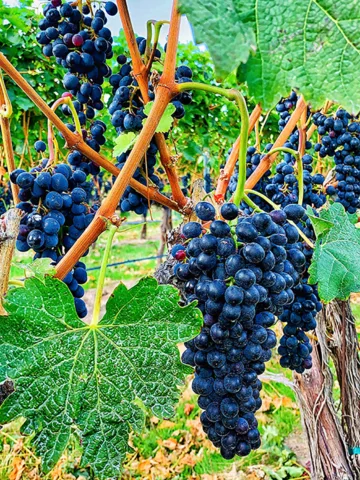While Italy can boast being a primary producer of both Prosecco and Moscato, each of these typically sparkling wines has unique characteristics that set them apart. Discover the delicious differences between Prosecco vs Moscato.

Effervescent and accessible, Prosecco has become increasingly popular among wine lovers in recent years. Worldwide sales in 2022 topped $3 billion dollars — a more than 10% rise from the previous year.
Moscato’s global sales are about half that of Prosecco’s, but this playful wine is also having a moment these days, with sales growing about 11% each year.
So what’s driving their demand? And what makes them unique? Here are some of the main differences between Prosecco and Moscato.




Jump to:
What is Prosecco?
Prosecco is often seen as a more affordable alternative to costlier Champagnes. But there’s a lot more to this sparkling wine than its relatively accessible price point.
Prosecco hails from the Veneto and Friuli-Venezia-Giulia wine regions in northeastern Italy. In order to qualify as Prosecco, the wine must contain at least 85% Glera grapes, a white wine grape native to neighboring Slovenia but brought to Italy several hundred years ago.
Generally, Prosecco is produced as either sparkling or semi-sparkling — spumante and frizzante, respectively.
In terms of style, it can range from Demi-Sec to Dry to Extra Dry to Brut Prosecco. Brut is actually the dryest, as it contains the least amount of residual sugar content. Prosecco’s texture is usually light, bubbly, and crisp.
What is Moscato?
Unlike Prosecco, Moscato wines can be either sparkling, semi-sparkling (lightly carbonated), or still, depending on the variety. And it comes in a range of other styles.
It’s produced using the Muscat grape, whose roots are believed to be among the oldest wine grapes in the world — dating back as far as the ancient Egyptians. The grapes can feature a range of shades from white and gold, to pink, red, brown, and black.
In fact, roughly 200 varieties of Muscat grapes exist. Two of the most common are the Moscato Bianco (also known as the Muscat Blanc à Petits Grains) and Muscat of Alexandria. The former is primarily grown in Italy and France. Italy is the main growing region for the latter.
Common styles of Moscato are sweet, crisp, and lightly effervescent, but it also comes in still and dessert wine varieties.
While Italy is one of the top Moscato producers it is also made in several other countries, including Spain, Portugal, Greece, France, and Germany, as well as in the United States and Australia.
Flavor profile: Prosecco
Prosecco wine is typically crisp and fresh, with light to medium body and moderate to high acidity. It commonly features notes of peach, pear, melon, and honeysuckle. And you can choose from subtly sweet to dry styles.

Like Champagne, Prosecco is carbonated, but the bubbles are usually larger and lighter, as the method used to create them is different. Prosecco producers generally use the Charmat method or Tank method of fermentation and aging.
With this process, second fermentation occurs in large tanks rather than in the bottle, as with the traditional method used for many high-quality Champagnes.
The tank method helps maintain Prosecco’s signature bright crispness. It’s also less labor-intensive, which is one reason why Prosecco can be a more affordable bubbly option.
In terms of alcohol content, Prosecco can range from around 9%-12.5% ABV, which is typical for most sparkling wines; though lower than many still wines.
Flavor Profile: Moscato
While Prosecco is commonly a dry sparkling white wine, Moscato comes in several styles and colors. Here are many of the most popular.

Moscato d’Asti
Moscato d’Asti is a semi-sparkling (or frizzante) sweet wine, and it has a very fruity flavor. It can feature notes of citrus fruits like orange and lemon, as well as peach, apricot, ripe pear, strawberry, honey, and rose petal.
Among the most widely consumed types of Moscato, it hails from the Piedmont region in northern Italy and is made using Moscato Bianco grapes. Good quality Moscato D’Asti will be sweet but clean, with a light body, zippy acidity, and a low alcohol content of between 5-6% ABV.
Asti
While Moscato d’Asti is semi-sparkling, Asti (or Asti Spumante) is a full sparkling wine. Both white wines are made with the same Moscato Bianco grape in the same region.
But Asti can be slightly sweeter, with flavors of stone fruits like peach and nectarine, as well as jasmine. And it can have a somewhat higher alcohol content, falling in the 7-10% ABV range.
Still Moscato
If you’re not a fan of bubbly but are curious about Moscato, try a still version. They have similar floral and fruity aromas and flavors as other Moscatos, but they can be a bit dryer. And they can be made with either Muscat Blanc à Petit Grains or the Muscat of Alexandria grape varieties.
Pink Moscato
Pink Moscato is a floral, sweet Italian wine, and as the name hints at, light pink in color. It’s made by mixing white Muscat Blanc with a bit of red wine, often Merlot, and it has notes of red fruit like strawberry, raspberry, and cherry. Pink Moscato is more popular with winemakers outside of Italy in regions like Australia and the U.S.
Both acidity and alcohol levels are fairly low in Pink Moscato, with ABV around 5-7%.
Moscato Rosa
Given its name, you might think that Moscato Rosa is pink in color. But this wine is not the same as Pink Moscato.
Moscato Rosa is actually a dark ruby red. It’s made from a red-purplish grape that’s related to the Muscat Blanc à Petits Grains — and it’s primarily produced in Italy’s northeastern Alto Adige region.
This style of Moscato gets its name from its special rose-like aroma. Common flavors on the palate are spiced berries, cloves, and cinnamon.
Red Moscato
Red Moscato is also a blend of white Moscato and red wine, typically Syrah or Zinfandel. It has a sweet flavor and is light red in color, with flavors of ripe berries and sweet citrus. The body is typically light and fresh with low acidity.
Moscato Dessert Wines
Among the sweetest Moscatos are the dessert-style wines. And one of the most popular is the Muscat de Beaumes de Venise, produced in France’s Rhône Valley.
This rich gold wine is made by combining the Muscat Blanc à Petits Grains and Muscat Noir grapes. Then it’s fortified with spirits. That halts the fermentation of the wine and leaves some residual sugar in it, boosting its sweetness. It also raises the alcohol content — to around 15% ABV.
DOC and DOCG for Prosecco and Moscato
In Italy, DOC and DOCG are special labels given to certain wines indicating standards of quality, based on the region where they are made.
DOGC signifies a Designation of Controlled and Guaranteed Origin. It refers to the areas of wine production with the best quality. DOC (designation of controlled origin) is a lower designation. These wines aren’t guaranteed by the Italian government to be in the same class as DOGC wines.
Proseccos can fall into a range of DOC and DOCG designations. As a rule of thumb, more affordable ones will hail from the “Prosecco DOC.” Higher quality and costlier ones will have a Prosecco Superiore DOCG, Prosecco Superiore Rive DOCG, or at the highest end, a Superiore di Cartizze DOCG designation.
When it comes to Moscato, Italian-made Moscato d’Asti and Asti Spumante both have the higher DOCG ratings.
Food pairings: Prosecco
Prosecco is a delicious complement to fried chicken, as the wine’s bright acidity will balance out the grease. And the effervescence of the wine goes well with the crunchy texture of the chicken.
The wine’s crisp fruitiness is also a nice counter-balance to salty, cured meats like prosciutto and salami. And it’s also a great pairing for spicier foods like curries and pad thai. For cheeses, try it with bold-flavored ones like Brie, Gruyere, and Parmigiano Reggiano.

Just be sure to chill your Prosecco before you serve it, as you would with other sparkling wines.
Food pairings: Moscato
Like Prosecco, Moscato wines will generally pair well with spicy foods, as the sweet taste of the wine can help balance out those foods’ strong flavors.
Try Moscato d’Asti with Thai Peanut Curry or Dragon Noodles.
Still types of Moscato can complement light seafood dishes and pastas that are not too rich — as well as soft cheeses like Brie and goat cheeses.
Fortified sweet dessert wine Moscato will pair well with creamy and fruity desserts, along with souffles and dark chocolates.
Price
Unlike a lot of pricier sparkling wines and Champagne, Prosecco is relatively affordable, which makes it a great choice for everything from a simple get-together with friends to a special occasion. You can pick up a good bottle for around $15 dollars, and they’re ready to drink without any cellaring. That said, some very high quality Proseccos hailing from the Cartizze DOCG can be in the $50+ range.
Moscato prices will vary depending on the style you buy and the quality. Expect to pay around $15 for a good bottle of Moscato d’Asti, whereas Red Moscato tends to average about $10 a bottle. Some of the dessert Moscatos can land more in the $25-$50 range.
Moscato vs Prosecco summary
Moscato
- Primary growing regions: Italy, France, Portugal, Spain, Germany, United States, Australia
- Sweet
- Body: Light to medium
- Color: Light and rich gold to pink and medium red
- Acidity: Medium-low to high
- Flavor notes: Orange, lemon, peach, apricot, ripe pear, strawberry, honey, rose petal (for Asti); red berries (Pink Moscato); spiced berries, cloves, and cinnamon (Moscato Rosa); ripe berries and sweet citrus (Red Moscato)
- Cost: $10 for Red Moscato; $15 for Asti; $25 and up for dessert Moscato
Prosecco
- Primary growing regions: Veneto and Friuli-Venezia-Giulia regions of Italy
- Dry to medium sweet
- Body: Light to medium
- Color: Pale straw yellow to light gold
- Acidity: Medium to high
- Flavor notes: Peach, pear, melon, and honeysuckle
- Cost: $15 for a good bottle; $50+ for very high quality
More wine tasting guides
Discover more wines, along with their food pairings and average costs. Check out the posts below.






Leave a Reply